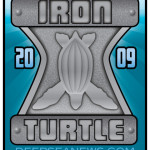

At Kevin’s request this week I focus on the Turtle, the first American submarine. Its 1776, with the American Revolution in full swing and on September 7 the world’s first submarine attack occurs.
The Turtle was the invention of David Bushnell, a Yale graduate who also invented the time bomb. The egg-shaped Turtle was a one-person submarine totally barely 7 feet in diameter operated under human power. Bushnell needed to solve several yet encountered engineering issues to design such a submersible (i.e. a watertight, pressure-proof hull; variable ballast; vertical and horizontal propulsion; weapons delivery). Propulsion occurred through a pedaled-operated propeller and buoyancy maintained by pumping water in/out of the hull via hand pump. Her hull was shaped oak timbers, caulked at the joints, bound with irong bands, and covered in pitch. The Turtle was designed to attach a keg of powder, with a timed fuse, to an enemy ship’s hull. Part of this process was to bore through the hull with a hand cranked drill. Another issue was that the air supply lasted a mere 30 minutes.

The first and only attack from the Turtle, under the operation of a Sergeant Ezra Lee, occurred on the 64 gun British warship, the HMS Eagle, in New York Harbor. Ezra was an army volunteer who trained for two months to operate the Turle. Bushnell was unable to pilot due to sickness. George Pararas-Carayannis (Turtle: A Revolutionary Submarine. Sea Frontiers, Vol 22, No. 4, pp. 234, July-August, 1976.) describes the attack…
Lee vainly tried to attach a torpedo to her hull. When the air in his little cabin was almost used up, Lee had no choice but to abandon his attempt and surface. After replenishing the air in the cabin and resting, he again descended underneath Eagle to try to affix a torpedo on her hull. He failed. A metal plate covered the area where he was trying to drill. Having consumed his air, he was forced to abandon his goal and surface. Lee was exhausted, and the outgoing tide threatened to take the small craft out to sea. Desperately, he ejected all the ballast water and began pedaling with all his remaining strength. With the ballast water pumped out, one third of Turtle’s hull stuck out of the water, making it clearly visible in daylight. In fact, as dawn broke, two British soldiers set out from Governor’s Island in a patrol skiff to investigate the floating object. To divert the patrol and to lighten his craft, Lee released a time operated 250-pound (250 pounds = 113 Kilograms) torpedo and, picking up speed, reached The Battery and safety.
Although the attack was unsuccessful, historians suggest that it was pivotal. The explosion led to Lord Howe ordering British ships to be repositioned further off the harbor. From this new location, the British blockade against New York was ineffective. Two subsequent Turtle missions were also unsuccessful due to unfavorable sea state. In the process of transporting the Turtle aboard a sloop to a more favorable area for attack, the sloop and Turtle were captured by the British. Little is known what became of her or the sloop.
Images from the Submarine Photo Index






http://www.nytimes.com/2007/08/04/arts/design/04voya.html?_r=2&ref=nyregion&oref=slogin&oref=slogin
The first armored battleship was also called The Turtle (“Kobukson“)- designed by Admiral Yi Sun-Sin in 16th Century Korea.
There’s your useless, interesting factoid for the day.